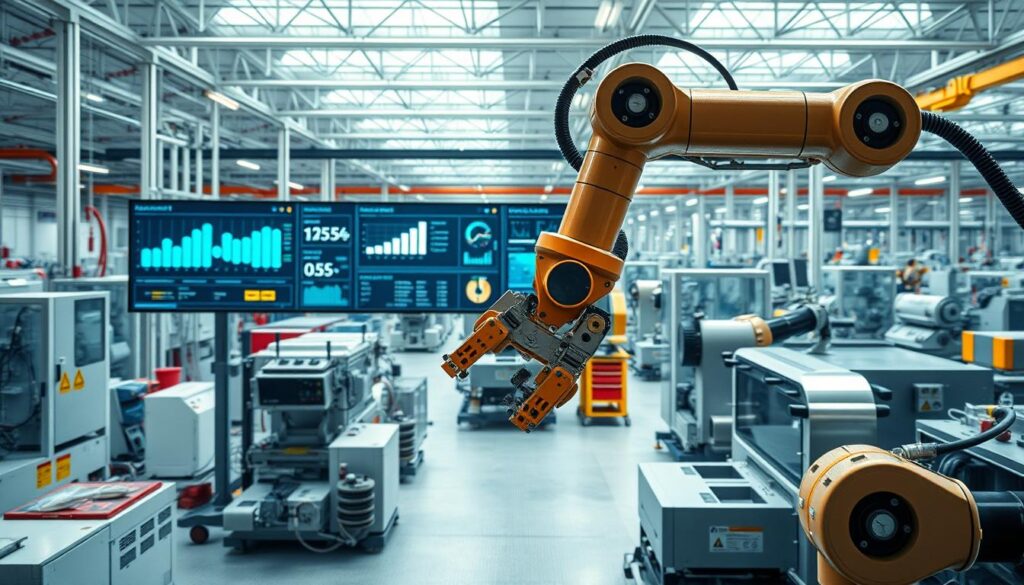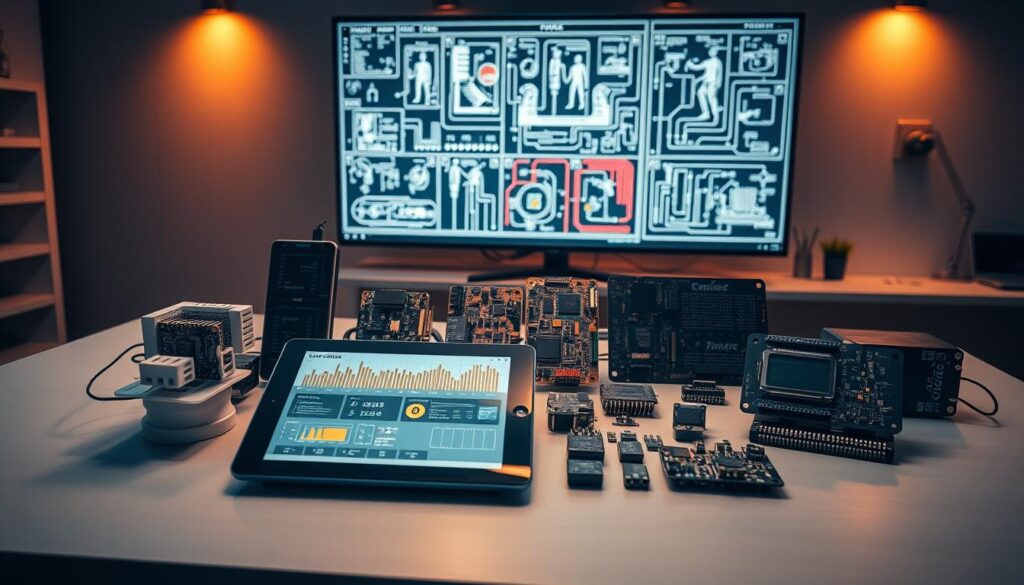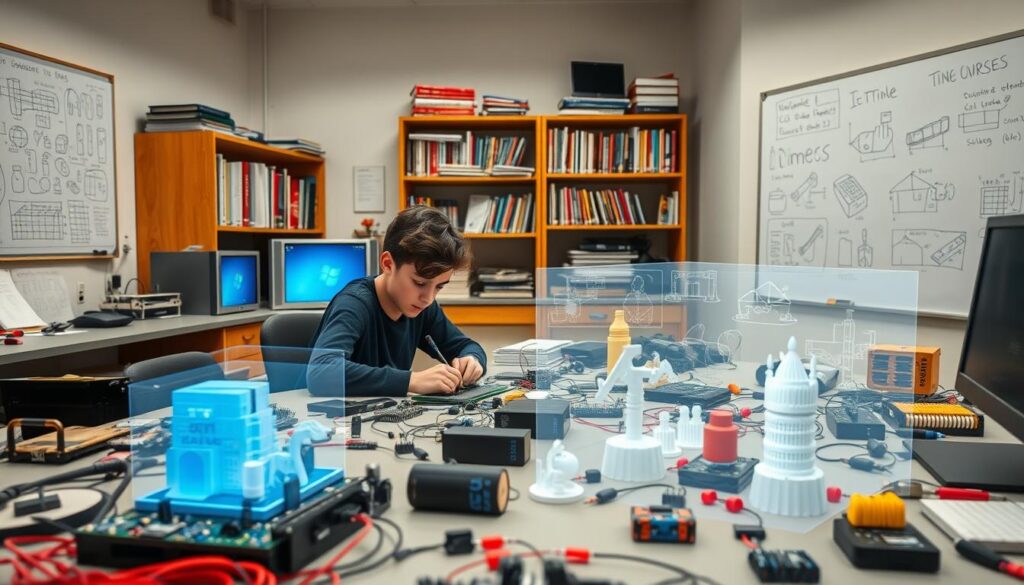As industries continue to evolve in an increasingly data-driven world, the ability to anticipate and respond to operational challenges is becoming a critical differentiator for businesses. The integration of Internet of Things (IoT) technologies is revolutionizing industrial engineering by enabling real-time monitoring and control of production processes.
This transformation is driven by the convergence of IoT, AI, and data analytics, which enables the creation of highly efficient and responsive manufacturing systems. By leveraging these technologies, industrial engineers can optimize processes, predict maintenance needs, and improve quality control, ultimately leading to improved product quality and customer satisfaction. For more insights on how industrial engineering can elevate operations, visit this resource.
Key Takeaways
- IoT technologies enable real-time monitoring and control of production processes.
- The integration of IoT, AI, and data analytics drives innovation and efficiency.
- Industrial engineers can optimize processes and predict maintenance needs using IoT and data analytics.
- Improved product quality and customer satisfaction are achieved through the application of IoT in engineering.
- Efficient manufacturing systems are created through the convergence of IoT, AI, and data analytics.
Understanding IoT in the Context of Engineering
In the context of engineering, IoT represents a paradigm shift towards more interconnected and intelligent systems. This technological advancement is not just about connecting devices; it’s about creating a network that can significantly enhance the efficiency, productivity, and innovation within the engineering field.
Definition of IoT
The Internet of Things refers to the global network of ‘smart’ physical objects, or ‘things’, which constantly collect and share data across the internet. As Kevin Ashton, the pioneer who coined the term IoT, aptly puts it, “The Internet of Things is a system of interrelated computing devices, mechanical and digital machines, objects, animals, or people that are provided with unique identifiers and the ability to transfer data over a network.”
Key Components of IoT
IoT technology comprises several key components that work together to enable its functionality. These include:
- Sensors and Actuators: These are the devices that collect data from the environment and perform actions based on that data.
- Connectivity: This refers to the various communication protocols and networks (like Wi-Fi, Bluetooth, etc.) that allow IoT devices to connect and exchange data.
- Data Processing: The data collected by IoT devices is processed and analyzed, often using cloud computing or edge computing.
- User Interface: This is how users interact with the IoT system, which can be through apps, web interfaces, or voice commands.
As McKinsey notes, “IoT is a complex system that requires the integration of various technologies to create a seamless experience.” This integration is what makes IoT so powerful in engineering applications.
Importance of IoT in Modern Engineering
IoT is transforming the engineering landscape in several significant ways. By enabling real-time data collection and analysis, IoT technology facilitates:
“The future of engineering is not just about designing and building; it’s about creating intelligent systems that can adapt and evolve.” –
Some of the key benefits include:
- Enhanced Efficiency: IoT allows for real-time monitoring and optimization of systems, leading to reduced waste and improved productivity.
- Innovative Solutions: The data collected through IoT devices can lead to insights that drive innovation in engineering.
- Predictive Maintenance: IoT enables predictive maintenance, reducing downtime and increasing the lifespan of equipment.
By understanding and leveraging IoT, engineers can create more sophisticated, efficient, and innovative solutions, marking a significant step forward in the field.
The Role of IoT in Smart Manufacturing

IoT solutions for engineering are transforming the manufacturing landscape by enhancing efficiency and productivity. The Industrial Internet of Things (IIoT) is at the forefront of this transformation, enabling manufacturers to leverage data from connected devices to optimize their operations.
The integration of IoT in smart manufacturing allows for real-time monitoring and control of production processes. This connectivity enables manufacturers to identify bottlenecks, reduce downtime, and improve overall product quality. By leveraging IoT solutions for engineering, companies can make informed decisions based on real-time data, addressing issues proactively and enhancing production processes.
Enhancing Production Processes
One of the key benefits of IoT in smart manufacturing is its ability to enhance production processes. By connecting machinery and equipment, manufacturers can gather data on performance, usage, and condition. This data can be analyzed to optimize production workflows, predict potential failures, and schedule maintenance accordingly.
For instance, companies like Siemens and GE Appliances are using IIoT to streamline their manufacturing processes. They are achieving significant improvements in efficiency and productivity by leveraging IoT-enabled devices and analytics platforms.
Predictive Maintenance Benefits
Predictive maintenance is another significant advantage of IoT in smart manufacturing. Traditional maintenance schedules are often based on fixed intervals, which can lead to unnecessary maintenance or, conversely, equipment failures between scheduled checks. IoT-enabled predictive maintenance allows manufacturers to monitor equipment condition in real-time, predicting when maintenance is required.
This approach not only reduces downtime but also extends the lifespan of equipment. By adopting predictive maintenance strategies facilitated by IoT, manufacturers can save on maintenance costs and improve overall operational efficiency.
In conclusion, the role of IoT in smart manufacturing is pivotal, driving innovation and efficiency through enhanced production processes and predictive maintenance benefits. As manufacturers continue to adopt IoT solutions for engineering, we can expect to see further advancements in this field.
Impact on Civil Engineering Projects
IoT technology is transforming the landscape of civil engineering projects. The integration of IoT devices and sensors enables real-time data collection, enhancing project monitoring and management. This leads to improved efficiency, reduced costs, and increased safety on construction sites.
Smart Infrastructure Development
The development of smart infrastructure is a significant benefit of IoT in engineering. IoT enables the creation of intelligent systems that can monitor and manage infrastructure such as bridges, roads, and buildings. These systems can detect potential issues before they become major problems, allowing for proactive maintenance and reducing the risk of failures.
For instance, IoT sensors can be used to monitor the structural health of bridges, detecting signs of wear and tear. This information can be used to schedule maintenance, ensuring the continued safety and integrity of the infrastructure.
Real-Time Monitoring Solutions
Real-time monitoring is another critical aspect of IoT in civil engineering. By leveraging IoT devices, project managers can monitor construction sites remotely, tracking progress and identifying potential issues promptly. This capability is particularly valuable for large, complex projects where on-site conditions can change rapidly.
Effective project management in civil engineering involves several key elements, as outlined in the following table:
| Element | Description | Benefits |
|---|---|---|
| Real-Time Monitoring | Continuous monitoring of construction sites | Improved safety, reduced delays |
| Predictive Maintenance | Using data to predict equipment failures | Reduced downtime, lower maintenance costs |
| Smart Infrastructure | Intelligent systems for infrastructure management | Enhanced durability, reduced maintenance needs |
For more insights on managing civil engineering projects, visit this resource for comprehensive guidance.
The IoT provides transparency on-site and encourages innovative thinking, leading to the creation of efficiencies, reduction of waste, and increased safety on construction and engineering projects. By adopting IoT solutions, civil engineers can significantly improve project outcomes and operational efficiency.
IoT Applications in Electrical Engineering

IoT applications in electrical engineering are transforming the industry through innovative solutions like smart grids and advanced energy management systems. The integration of IoT devices in engineering is enhancing the efficiency, reliability, and safety of electrical systems.
Smart Grid Technology
Smart grid technology is one of the most significant applications of IoT in electrical engineering. It involves the use of IoT devices to manage and monitor the distribution of electricity in real-time, allowing for more efficient energy distribution and consumption. As noted by industry experts, “The smart grid is not just about adding intelligence to the grid; it’s about creating a more resilient, efficient, and sustainable energy system.”
“The smart grid represents a quantum leap in the way we manage energy, making it possible to integrate renewable energy sources more effectively.”
The benefits of smart grid technology include improved energy efficiency, reduced power outages, and enhanced consumer engagement through real-time data analytics. For instance, IoT devices can detect faults in the grid and predict potential failures, enabling proactive maintenance and reducing downtime.
Energy Management Systems
Energy management systems (EMS) are another critical application of IoT in electrical engineering. EMS utilize IoT devices to monitor and control energy usage in buildings and industrial settings, optimizing energy consumption and reducing waste. According to a report on engineering the future, the integration of IoT in energy management can lead to significant cost savings and reduced environmental impact.
The key features of EMS include real-time monitoring, predictive analytics, and automated control systems. These features enable facility managers to make informed decisions about energy usage and identify opportunities for energy savings.
In conclusion, the application of IoT in electrical engineering, particularly in smart grid technology and energy management systems, is driving significant advancements in the field. By leveraging IoT devices in engineering, the industry can achieve greater efficiency, reliability, and sustainability.
Challenges Facing IoT Adoption in Engineering
The engineering industry’s shift towards IoT is hindered by several challenges, notably data security concerns and the difficulty of integrating with existing infrastructure. As IoT adoption becomes more widespread, addressing these challenges is crucial for the successful implementation of IoT technologies.
Data Security Concerns
One of the primary challenges facing IoT adoption in engineering is data security. With the increased connectivity of devices, the risk of cyber-attacks and data breaches also rises. Ensuring the security of IoT systems is paramount to prevent unauthorized access and protect sensitive information.
To mitigate these risks, engineers can implement robust security measures, such as encryption, secure authentication protocols, and regular software updates. By prioritizing data security, the engineering industry can build trust in IoT technologies and facilitate their widespread adoption.
Integration with Legacy Systems
Many factories still rely on outdated legacy systems not designed to integrate with modern Industrial Internet of Things (IIoT) devices. This incompatibility poses a significant challenge to IoT adoption in engineering.
To overcome this hurdle, companies can adopt a phased integration approach, gradually replacing or upgrading legacy systems to ensure compatibility with IoT devices. Alternatively, implementing middleware solutions can enable communication between legacy systems and modern IoT technologies.
| Challenge | Description | Potential Solution |
|---|---|---|
| Data Security Concerns | Increased risk of cyber-attacks and data breaches with IoT adoption | Implement robust security measures like encryption and secure authentication |
| Integration with Legacy Systems | Incompatibility between legacy systems and modern IoT devices | Adopt phased integration or use middleware solutions |
By understanding and addressing these challenges, the engineering industry can more effectively adopt IoT technologies, enhancing efficiency and driving innovation. For more insights on IoT in engineering, visit World Civil Society.
The Future of IoT in Engineering

Emerging trends in IoT are expected to have a profound impact on the engineering industry. As technology continues to evolve, the integration of IoT in engineering is poised to drive significant advancements across various sectors.
Emerging Trends to Watch
Several emerging trends are set to shape the future of IoT in engineering. These include:
- Edge Computing: Reducing latency and improving real-time processing capabilities.
- Artificial Intelligence (AI) Integration: Enhancing predictive maintenance and decision-making processes.
- 5G Connectivity: Facilitating faster data transfer and more reliable connections.
According to a report by McKinsey, “the adoption of IoT technologies is expected to increase productivity by up to 30% in some industries.” This underscores the potential of IoT to transform engineering practices.
Predictions for Industry Growth
The IoT market in engineering is predicted to experience significant growth in the coming years. Key predictions include:
- A compound annual growth rate (CAGR) of over 20% through 2025.
- Increased adoption of IoT solutions in smart manufacturing and infrastructure development.
- Greater emphasis on data security and privacy.
As
“The future of IoT is not just about connected devices; it’s about creating a more efficient, sustainable, and innovative world.”
This vision for the future highlights the transformative potential of IoT in engineering.
In conclusion, the future of IoT in engineering is bright, with emerging trends and technologies driving growth and innovation. As the industry continues to evolve, it is essential for engineers and stakeholders to stay informed and adapt to these changes.
Case Studies of Successful IoT Implementations
IoT has emerged as a game-changer in engineering, with multiple industries reporting significant benefits from its adoption. The technology has enabled companies to optimize their operations, improve efficiency, and reduce costs.
Automotive Industry Examples
The automotive industry has seen significant advancements with the integration of IoT. For instance, General Electric’s (GE) Brilliant Manufacturing system is a prime example of Industrial IoT (IIoT) in action. It captures real-time machine data from the factory floor, optimizing performance and availability. This has led to improved production processes and reduced downtime.
Other automotive manufacturers have also leveraged IoT to enhance their manufacturing processes. By implementing IoT solutions, they have been able to predict maintenance needs, reduce energy consumption, and improve product quality.
Aerospace Applications
The aerospace industry has also benefited from IoT implementations. IoT sensors are used to monitor aircraft performance in real-time, enabling predictive maintenance and reducing the risk of in-flight failures. This not only improves safety but also reduces maintenance costs and downtime.
Furthermore, IoT has enabled the aerospace industry to optimize supply chain management. By tracking components and monitoring inventory levels in real-time, manufacturers can respond quickly to changes in demand and reduce lead times.
The successful implementation of IoT in these industries demonstrates its potential to drive innovation and efficiency in engineering. As the technology continues to evolve, we can expect to see even more significant benefits across various sectors.
The Importance of Data Analytics in IoT

The integration of data analytics in IoT has opened new avenues for real-time decision-making in various engineering fields. IoT devices gather data from their surroundings and send it to a central system where it is analyzed and used to make decisions.
Transforming Raw Data into Insights
Data analytics is crucial in transforming the vast amounts of raw data collected by IoT devices into meaningful insights. This process involves several steps, including data cleaning, processing, and analysis. By leveraging advanced analytics techniques, engineers can uncover patterns and trends that would otherwise remain hidden.
For instance, in the context of internet of things in engineering, data analytics can help predict maintenance needs, optimize production processes, and enhance overall system efficiency. The role of data analytics in IoT is further emphasized by its ability to provide actionable insights that drive informed decision-making.
Real-Time Decision Making
One of the key benefits of IoT is its ability to facilitate real-time decision-making. By analyzing data as it is collected, engineers can respond quickly to changes in their environment, improving responsiveness and reducing the risk of costly downtime.
- Enhanced operational efficiency through timely interventions
- Improved safety by predicting and preventing potential hazards
- Optimized resource allocation based on real-time data analysis
The importance of data analytics in IoT cannot be overstated, as it enables the effective utilization of IoT technology in engineering. By transforming raw data into insights and facilitating real-time decision-making, data analytics plays a vital role in driving innovation and efficiency in various engineering disciplines.
IoT and Sustainability in Engineering
The integration of IoT in engineering is revolutionizing sustainability efforts. By leveraging IoT solutions for engineering, companies can significantly reduce their environmental footprint.
One of the primary ways IoT contributes to sustainability is by reducing waste and energy consumption. For instance, factories that deploy IIoT enable systems to work autonomously, optimizing everything from energy consumption to production schedules. This not only enhances efficiency but also minimizes unnecessary waste.
Reducing Waste and Energy Consumption
IoT technology allows for real-time monitoring and management of resources. By analyzing data from various sensors and devices, engineers can identify areas of inefficiency and implement corrective measures. This proactive approach to resource management can lead to significant reductions in energy consumption and waste.
According to industry experts, the adoption of IoT in engineering can lead to more sustainable practices. As noted in an article on The Engineer’s role in enhancing sustainability in, IoT plays a crucial role in optimizing industrial processes, making them more eco-friendly.
Promoting Eco-friendly Practices
IoT also promotes eco-friendly practices by enabling the use of renewable energy sources and reducing reliance on non-renewable resources. Smart grids, powered by IoT, can efficiently manage energy distribution, ensuring that it is used where and when it’s needed most.
Furthermore, IoT facilitates the development of sustainable infrastructure. By integrating IoT into civil engineering projects, cities can become smarter and more sustainable, with systems in place to manage waste, water, and energy more effectively.
The benefits of IoT in engineering are multifaceted, contributing to a more sustainable future. As the technology continues to evolve, we can expect to see even more innovative applications of IoT in promoting sustainability.
Collaborations between Engineers and Tech Innovators

Collaborations between engineers and tech innovators are driving the future of IoT integration in engineering. The fusion of technological expertise with engineering knowledge is creating innovative solutions that are transforming the industry.
One of the key drivers of this innovation is the role of startups in IoT development. Startups are bringing fresh perspectives and agility to the development of IoT devices in engineering. They are leveraging cutting-edge technologies to create novel solutions that address specific engineering challenges.
Role of Startups
Startups are particularly adept at identifying niche areas where IoT can be applied to improve engineering processes. Their ability to quickly adapt and innovate is enabling the development of specialized IoT devices that cater to the unique needs of various engineering disciplines.
For instance, some startups are focusing on developing IoT solutions for predictive maintenance in manufacturing. By integrating sensors and advanced analytics, these solutions enable real-time monitoring and predictive maintenance, reducing downtime and increasing overall efficiency.
Partnerships with Tech Giants
In addition to startups, partnerships with tech giants are also playing a crucial role in advancing IoT integration in engineering. These collaborations bring together the resources and expertise of established tech companies with the knowledge of engineers to develop scalable and robust IoT solutions.
For example, a recent collaboration between a tech giant and engineering firms has led to the development of advanced IoT platforms that facilitate smart infrastructure development.
| Collaboration Type | Benefits | Examples |
|---|---|---|
| Startups | Innovative solutions, agility, niche focus | Predictive maintenance IoT devices |
| Tech Giants | Scalability, robust solutions, resource-rich | Advanced IoT platforms for smart infrastructure |
Human-in-the-loop (HITL) systems exemplify the synergy between human expertise and IoT, managing exceptions and making complex decisions beyond algorithms. This collaboration is crucial for the successful implementation of IoT devices in engineering.
Regulatory Considerations for IoT in Engineering
The integration of IoT in engineering is not just about technology; it’s also about navigating complex regulations. As IoT solutions become more prevalent, businesses must ensure they are compliant with various regulatory guidelines.
Understanding Compliance Guidelines
Compliance guidelines for IoT in engineering are multifaceted, involving data security, privacy, and industry-specific regulations. For instance, in the United States, IoT devices must comply with standards set by the National Institute of Standards and Technology (NIST). To learn more about complying with industry regulations for your specific IoT application, you can refer to resources such as this guide.
Understanding these guidelines is crucial for the successful implementation of IoT solutions. It involves not just initial compliance but ongoing monitoring and updates to ensure continued adherence to evolving regulations.
| Regulatory Aspect | Description | Impact on IoT in Engineering |
|---|---|---|
| Data Security | Measures to protect IoT devices and data from cyber threats. | Ensures the integrity and confidentiality of data transmitted by IoT devices. |
| Privacy | Regulations governing the collection, storage, and use of personal data by IoT devices. | Protects individuals’ privacy by limiting the type of data IoT devices can collect and how it is used. |
| Industry-specific Regulations | Standards and guidelines specific to certain industries, such as healthcare or finance. | Dictates how IoT solutions can be implemented in various sectors, ensuring compliance with industry norms. |
The Role of Government Policies
Government policies play a significant role in shaping the regulatory landscape for IoT in engineering. These policies can influence the development and deployment of IoT technologies by setting standards, providing guidelines, and enforcing compliance.
Key aspects of government policies include:
- Standardization: Governments can promote standardization across industries, facilitating interoperability and security.
- Incentives: Governments may offer incentives for compliance or for the development of IoT technologies that meet certain criteria.
- Regulatory Frameworks: Establishing clear regulatory frameworks helps businesses understand their obligations and plan accordingly.
In conclusion, regulatory considerations are a critical aspect of IoT adoption in engineering. By understanding compliance guidelines and the role of government policies, businesses can navigate the complex regulatory landscape and ensure the successful implementation of IoT solutions.
Educational Resources for Engineers on IoT

The rapidly evolving field of IoT in engineering necessitates a commitment to ongoing education and training. As IoT technologies continue to advance and become more integral to engineering practices, professionals in the field must stay updated on the latest tools, methodologies, and applications.
Online Courses and Certifications
Engineers can enhance their knowledge of IoT through various online courses and certification programs. These educational resources cover a wide range of topics, from the fundamentals of IoT to specialized areas such as data analytics and IoT security. For instance, the IEEE IoT Education offers a variety of courses designed to equip engineers with the skills needed to excel in IoT-driven projects.
Some of the key benefits of online courses include flexibility, allowing engineers to learn at their own pace, and access to a broad spectrum of topics that might not be available through traditional educational channels. Certifications, on the other hand, provide a recognized credential that can enhance an engineer’s professional profile.
Industry Conferences and Workshops
In addition to online learning, industry conferences and workshops offer valuable opportunities for engineers to learn about the latest developments in IoT. These events provide a platform for networking with peers, sharing experiences, and gaining insights from industry leaders. Conferences often feature presentations on cutting-edge research and case studies of successful IoT implementations.
Workshops, typically more hands-on, allow participants to engage in practical exercises and gain direct experience with IoT technologies and tools. Both conferences and workshops are essential for staying current with the rapidly evolving IoT landscape.
By leveraging these educational resources, engineers can ensure they remain at the forefront of IoT innovation, equipped with the knowledge and skills necessary to drive future advancements in the field.
Conclusion: Embracing IoT for Engineering Excellence
The integration of IoT in engineering has revolutionized the way industries operate, driving innovation and efficiency. By connecting machines and systems, IoT enables real-time data sharing, predictive maintenance, and smarter decision-making.
Key Benefits of IoT in Engineering
IoT applications in engineering have transformed manufacturing processes, enabling predictive maintenance and reducing downtime. IoT solutions for engineering have also promoted sustainability by reducing waste and energy consumption.
Future of IoT in Engineering
As IoT continues to evolve, it is expected to drive further innovation in engineering. By embracing IoT, engineers can unlock new opportunities for growth and development, leading to engineering excellence.
